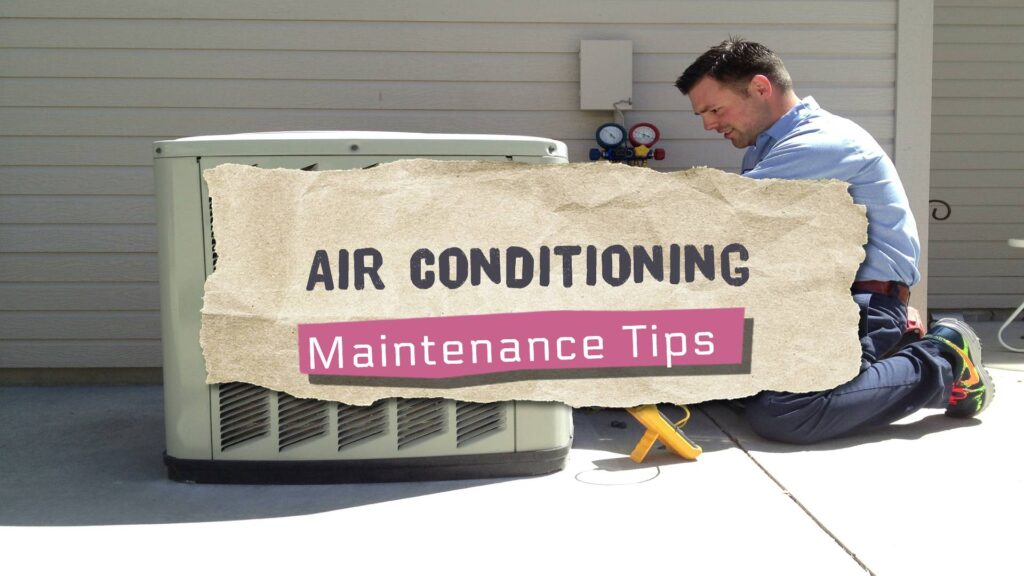Maximize Your Comfort: Proven Strategies for Air Conditioning Maintenance
As the vibrant season of spring blooms, it’s essential to prepare your air conditioning system for the intense heat of summer. With rising temperatures, your cooling unit transforms into a critical ally in preserving a comfortable atmosphere within your home. It’s easy to take central air conditioning for granted until it fails. Therefore, these Air Conditioning Maintenance Tips are invaluable. By addressing maintenance proactively, you can ensure that your AC unit stays in peak condition, providing much-needed relief during those sweltering summer days.
The efficiency and performance of your air conditioning unit rely heavily on routine maintenance of essential components such as coils, filters, and fins. Failing to care for these vital parts can lead to a slow decline in performance and increased energy consumption. By prioritizing maintenance, you not only enhance the functionality of your unit but also significantly reduce energy costs and extend its lifespan. This proactive strategy helps you avoid costly repairs and replacements, as neglected filters and coils can severely hinder efficiency, potentially causing critical components like the compressor or fans to fail prematurely.
To guarantee that your air conditioning unit operates at its best, it demands regular attention and care. The optimal time for maintenance is just before you begin relying on the system to cool your home extensively. By dedicating time to maintenance now, you can relish a cool and comfortable environment throughout the summer, free from unexpected breakdowns and discomfort.
In the sections below, we will explore some of the most effective air conditioning maintenance strategies that will help keep your home refreshingly cool and comfortable throughout the warmer months.
Elevate Performance by Regularly Replacing Your Air Conditioning Filters
Replacing your air filter is a fundamental yet impactful task to enhance airflow and keep your AC unit functioning efficiently. This straightforward maintenance action can save you from costly repairs later on. Generally, it’s advised to change standard filters every 30 days, whereas thicker pleated filters may have a longer lifespan. To help you stay on track, consider marking replacement dates on your calendar as a reminder to consistently swap out your filters.
Your HVAC system’s filter should ideally be replaced at least four times per year. However, if you live in a particularly dusty environment or have pets that shed, you may need to change it even more frequently. Always be sure to select a replacement filter that matches the airflow rating of the original. Exercise caution with air purifying or HEPA filters, as these can significantly impede airflow. If airflow is restricted, it could lead to the indoor coil freezing, severely impairing the system’s overall function.
To effectively change the filter, locate the housing unit on your indoor furnace or air conditioner. You may require a screwdriver to unlock and open the filter housing door. Next, carefully remove the old filter and replace it with a new one, ensuring that the airflow direction arrows on the filter are aligned with those on your unit. Once the new filter is in place, securely close and latch the door to finalize the process.
Achieve Optimal Air Conditioning Performance with a Clean Condenser Unit
Important: Always Turn Off Power Before Maintenance!
When maintaining your air conditioning system, prioritizing safety is of utmost importance. The potential dangers posed by electrical power in conjunction with moving parts in the air conditioner require that you completely shut off the power. You can find the exterior shut-off box near the condenser or turn off the power at the breaker box to ensure your safety during maintenance procedures.
Another crucial aspect of maintenance is ensuring that your condenser stays clean. A thorough rinse with a garden hose at least once a year—or more often if necessary—will help eliminate grass clippings, leaves, dirt, and other debris that can obstruct airflow. While most AC units are designed for outdoor use and can withstand a hose spray, it’s wise to check your owner’s manual or consult an HVAC professional beforehand. Don’t forget to turn off the power at the circuit panel before cleaning and keep it off for at least thirty minutes afterward. While rain typically poses no risk to the fan motor inside the condenser, a hose spray could. Avoid using a brush for cleaning, as the fins are delicate and can bend, which hinders airflow and reduces efficiency.
Thoroughly Eliminate All Debris Surrounding Your AC Unit
To effectively maintain your air conditioning system, it’s essential to clear away any visible debris from the outdoor condenser/compressor. Begin by detaching the fan cage on the exterior of the unit. Using a wrench or screwdriver, carefully remove the fasteners and lift off the enclosure or fan grille from the top of the AC unit. Clear out all accumulated leaves and debris either by hand or with a wet/dry vacuum.
Once the fan cage is removed, take the time to thoroughly clean the area surrounding the condenser/compressor. This can be done either by hand or using a wet/dry vacuum cleaner. This step is crucial for removing leaves and other debris that may have built up inside the unit, which can negatively impact its performance and efficiency.
Gently Clean and Straighten Any Bent Fins for Better Airflow
After removing the outer covers, utilize the brush attachment on a shop vacuum to eliminate all caked-on dirt. Then, using a gentle stream of water from your garden hose, spray the fins from the inside out to dislodge any debris trapped between them. Avoid using a pressure washer, as high pressure can damage the delicate fins. If the fins are excessively dirty, consider using a specially formulated fin cleaning spray available at local home improvement stores; just be sure to follow the manufacturer’s instructions for optimal results.
Ensure Proper Fin Alignment for Enhanced Efficiency
Maintaining the alignment of the fins is crucial, as bent fins can significantly diminish the efficiency of your air conditioning unit. Since any obstruction to airflow through the fins can reduce overall efficiency, it’s vital to take the time to carefully straighten any bent fins using a butter knife or a specialized fin-straightening tool. Exercise caution during this process to prevent damage to the tubing embedded within the fins, which could lead to further issues.
Establish an Efficient Environment by Keeping the Condenser Area Clear
It’s essential to keep the area surrounding your condenser free from weeds and to maintain a safe distance between lawn furniture and other items, ideally at least a few feet away. This practice promotes optimal circulation around the unit and ensures easy access for service personnel during maintenance visits, which is crucial for the longevity and effectiveness of your system.
Many homeowners choose to plant shrubs around their condenser to improve aesthetics and help it blend into the landscape. While this can enhance the visual appeal of your outdoor space, it’s important to keep these plants trimmed back, allowing for at least a couple of feet of clearance on all sides of the unit. Proper airflow is vital for your air conditioning unit to operate efficiently. Strategically positioned shrubs can provide shade for the condenser, thereby protecting the finish, enhancing efficiency, and potentially extending the unit’s lifespan. Opting for evergreen shrubs is a wise choice, as they retain their leaves during winter, ensuring year-round coverage and aesthetic appeal.
Plan Wisely for Optimal Air Conditioning Maintenance
When considering the planting of new shrubs, it is essential to think ahead and contemplate their mature size, ensuring you plan their locations wisely. This foresight will help maintain adequate space behind the unit for accessibility. If you have pets that frequent the yard near the condenser, experts recommend installing a protective fence around the unit. Such fencing can safeguard both your pet and the condenser while facilitating proper airflow. Choose materials that will not obstruct airflow and ensure you include a gate for easy accessibility during maintenance.
In winter, if you decide to cover the condenser to protect it from debris, ensure that you only cover the top of the unit. This precaution allows for adequate airflow through the sides, preventing moisture buildup that could lead to damage. Always remember to remove the cover before turning on the air conditioning system in the spring. Additionally, it’s critical to verify that your outdoor unit is indeed an air conditioning condenser, as heat pumps should never be covered to avoid operational issues.
Regularly Verify the Level of the AC Pad for Optimal Functionality
It’s vital to ensure that the condenser unit is level, as an unlevel position can result in premature failure. Over time, the platform supporting the condenser may settle as the soil beneath it shifts. Regularly check the levelness of the condenser and use rot-resistant shims to adjust it back to the proper height. However, if you have a heat pump system, a slight slope away from the foundation is acceptable to facilitate defrosting during winter months.
Unclogging a Blocked Evaporator Drain is Crucial for System Functionality
Inside your home, warm, moist air circulates through the evaporator coil, where the cold surface absorbs heat, cooling the air before it re-enters your living spaces. As the warm air cools, moisture condenses on the coil, trickling into a pan below and moving through a drainpipe, typically directed toward a basement floor drain or outdoors.
Over time, mold and algae can accumulate, potentially clogging the drain hose. If the drain is flowing slowly or not functioning at all, it will need to be cleared. A clogged drain can cause water to spill onto floors or, if equipped with a drain float, may lead to the system halting cooling to prevent flooding, which can be a significant inconvenience and damage to your home.
Identify the Location of the Drain Line Exit for Effective Maintenance
First, locate where the drain line exits the evaporator coil enclosure. Typically, the drain consists of a one-inch PVC pipe. Follow this pipe to where it drains out, which is usually outside near the condenser unit. In some instances, it may drain into a basement floor drain, a utility sink, or, if located in an attic, down an outside wall.
Once you’ve identified the drain line location, employ a wet/dry vacuum to clear any blockages. Be sure to remove the paper filter from the vacuum to avoid damage. Position the vacuum hose at the end of the drain line, sealing any gaps with duct tape or cloth. Turn on the vacuum for several minutes, then switch it off. This process will help eliminate any organic matter buildup that could impede drainage.
Comprehensive Maintenance Strategies for Central Air Conditioning Systems
While these straightforward DIY maintenance tasks can help keep your AC system operating effectively, it’s essential to remember that certain maintenance tasks necessitate a qualified HVAC technician. For instance, a slow refrigerant leak can lead to costly compressor failure, an issue that the average homeowner may not possess the tools or expertise to inspect properly.
The Crucial Importance of Clean Air Ducts for System Efficiency
Moreover, the significance of clean air ducts and proper airflow cannot be overstated, as they are vital to the overall efficiency of an air conditioning system. Many homeowners lack the necessary skills, tools, and equipment to conduct thorough duct cleaning. Ultimately, while some air conditioning maintenance tasks can be performed biannually by the homeowner, it’s still paramount to have a professional HVAC technician conduct periodic inspections. Experts recommend scheduling these inspections during the spring and fall to ensure your system operates at its best.
A professional inspection can also help identify and address minor issues before they escalate into more significant and costly problems. By implementing these air conditioning maintenance tips, you can keep your unit functioning at its highest potential!
These invaluable air conditioning maintenance tips have been provided by Blake Heating and Cooling Griffin GA.
The Article Air Conditioning Maintenance Tips From Expert Technicians was found on https://limitsofstrategy.com.
The Article Expert Technicians Share Air Conditioning Maintenance Tips First Appeared ON
: https://ad4sc.com




It’s insightful to emphasize the importance of routine maintenance for air conditioning systems, especially as we transition into the hot summer months. From my experience, I’ve found that neglecting small issues early on—like a dirty filter—can lead to larger, more costly problems down the line.
You bring up a really important point about routine maintenance, especially as the summer heat starts ramping up. It’s interesting how something as simple as a dirty filter can end up causing so many headaches later on. I’ve definitely learned that the hard way too.
It’s interesting you mention the small issues like a dirty filter. I once had a similar experience where I ignored a couple of warning signs, thinking they weren’t a big deal. Eventually, I ended up not only having to replace the unit but also dealing with the discomfort of summer heat. It taught me a lesson about how interconnected maintenance is with overall comfort and well-being, both at home and in our personal lives.
I recently came across a piece that discusses how different air conditioning options can really benefit those with asthma, and it offers some practical insights that tie in nicely with the need for regular maintenance to avoid complications.
‘Which Air Conditioning Is More Beneficial For An Asthmatic?’
https://www.intrepid21.com/which-air-conditioning-is-more-beneficial-for-an-asthmatic/.
You’ve hit the nail on the head with that observation about routine maintenance. It’s easy to overlook something as seemingly small as a dirty filter, but as you said, those little details can snowball into bigger issues that not only affect our comfort but also our wallets. I remember when I first learned about the importance of regular upkeep—I ended up with a dead AC unit during a heatwave because I ignored the signs. It really drives home how our environments influence our well-being, especially in extreme weather.
Your insights about the importance of proactive air conditioning maintenance are indeed timely and resonate deeply with many of us. As someone who has experienced the discomfort of a malfunctioning AC unit during sweltering summer months, I can attest to the critical nature of the tips you’ve outlined.
It’s great to hear your perspective on proactive air conditioning maintenance. I think many of us can relate to that uncomfortable feeling when the AC suddenly malfunctions on a hot day. It’s not just a matter of comfort; it can really affect our mood and productivity, too.